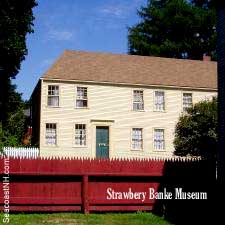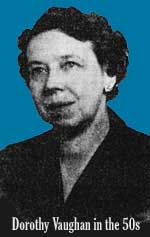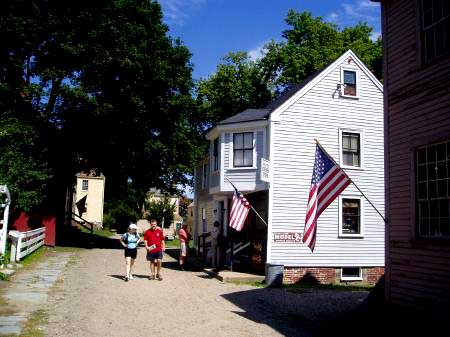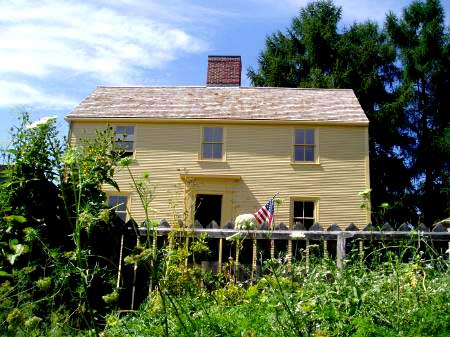| Who Really Started Strawbery Banke? |

BEHIND THE LEGEND
Like Paul Revere, historian Dorothy Vaughan woke Portsmouth citizens to an invasion. Progress, she said, was destroying the colonial character. The city responded and preserved over 30 buildings in Strawbery Banke Museum. It all started in June 1957 – or did it? The simple truth is – there is no simple truth.
Time compresses history much the way it compresses coal, but faster. It only takes a few years to squeeze a legend from layers of facts. Like a diamond, the legend is attractive, crystal clear and almost indestructible.
Excerpted and adapted from STRAWBERY BANKE:: A Seaport Museum 400 Years in the Making by J. Dennis Robinson. Click below to purchase our book.
A Star is Born
 According to legend, Portsmouth librarian Dorothy Vaughan started Strawbery Banke Museum. She gave a rousing speech to the Portsmouth Rotary in 1957. She warned the business community that the Old Town by the Sea was crumbling. Portsmouth was selling its soul in the name of progress. Bowling alleys, honkytonks and stores with plate glass windows and neon signs were taking the place of grand colonial homes. Pretty soon, she said, Portsmouth would look like Main Street, USA.
According to legend, Portsmouth librarian Dorothy Vaughan started Strawbery Banke Museum. She gave a rousing speech to the Portsmouth Rotary in 1957. She warned the business community that the Old Town by the Sea was crumbling. Portsmouth was selling its soul in the name of progress. Bowling alleys, honkytonks and stores with plate glass windows and neon signs were taking the place of grand colonial homes. Pretty soon, she said, Portsmouth would look like Main Street, USA.
Inspired by this speech, local citizens rallied to save more than two dozen colonial buildings from the bulldozers of urban renewal. Puddledock on the Piscataqua River, the site of one of the nation’s oldest settlements, was transformed from a run-down neighborhood into a 10-acre museum. Dorothy Vaughan, who died just shy of her 100th birthday last year, became the first president of the new nonprofit agency. Strawbery Banke Museum thrives and is approaching its own 50th anniversary.
That is the short version. Examined closely, legends and diamonds reflect many facets of the truth. Taken at face value, they can blind us to the facts. We may forget, for instance, that Strawbery Banke Museum was a group effort. A lot of people made it happen. This is really a more interesting and complex tale of a town saving itself.
A Quick History Lesson.
No buildings remain from the small 1630-era colony of settlers who discovered a bank of wild strawberries about two miles in from the mouth of the Piscataqua River. The oldest house in modern Strawbery Banke dates from 1695. Portsmouth became an important world port in colonial days, but it peaked early. The sophisticated aristocratic city faded in the early 1800s. Portsmouth turned to shipbuilding, but never regained its prominence. A nostalgic sense of faded glory, a longing for wealthier days became ingrained in the Portsmouth culture. The city’s fine colonial mansions, weathered and crumbling, served as a reminder of better days gone by.
Portsmouth’s South End mirrored the city’s economic decline. The Puddledock waterfront area evolved from a bustling world tradeport to a densely populated working class neighborhood. Water Street became the local "combat zone" as well as its "melting pot" of immigrant arrivals. In the 1950s this neighborhood was officially designated as "blighted" by a federal study and slated to be completely torn down. Instead, for the first time in American history, urban renewal combined with historic preservation
Continue with WHO STARTED STRAWEBRY BANKE?
The Story Behind the Scenes (continued)

Portsmouth Practices Preservation
The saving of 27 houses and the start of Strawbery Banke was the culmination of a series of events that came to a head in 1958. But it was not the first time that local citizens had come together to preserve its unique architectural heritage. The city’s first pocket guide to historic houses was published in 1869. A tourist boom after the Civil War drew national attention to the faded colonial seaport.
The process began one house at a time. The local trend toward individual house museums began in 1908 with the opening of the Thomas Bailey Aldrich House on Court Street, now part of Strawbery Banke. The Wentworth-Gardner house (1760) and the John Paul Jones House (1758) opened to the public in the 1920s, followed by the Warner House (1713) a decade later. The Moffatt-Ladd (1763), Jackson (1664), Langdon (1784), Lear (1740), Wentworth-Coolidge (1753) and Rundlett-May houses (1807) followed. But no one thought to preserve an entire neighborhood.
The waterfront saw a massive change when Charles Prescott died in 1932 leaving a $3 million fortune to his two sisters Josie and Mary. They used the money to buy up and destroy all but two buildings on the water side of the street to create a public park across from what would later become Strawbery Banke Museum.
The idea of turning the waterfront into a tourist Mecca actually dates to the 1930s. Architect John Mead Howells, a Kittery summer resident, conceived a plan to create an historic maritime village. With naval historian Stephen Decatur he hoped to preserve the buildings and rebuild a replica of Portsmouth in its heyday, complete with tall ships.
The National Park Service took an interest in the Howells/Decatur plan and listed the Portsmouth waterfront among its top ten potential projects. A government-sponsored survey examined over 200 buildings in the Puddledock area. But the National Park Service took a pass on Portsmouth. In 1935. The idea was not financially feasible. Howells and Decatur tried shopping their Maritime Village idea to other backers, but no funding was found. In 1940, Capt. Chester Mayo of the Portsmouth Naval Shipyard spearheaded a plan to survey and restore the waterfront neighborhood. Librarian Dorothy Vaughan was among the volunteers. But Mayo was transferred out of town, war intervened and the plan lapsed.
Continue with WHO STARTED STRAWEBRY BANKE?
The Story Behind the Scenes (continued)

How Everything Changed
It was not a single speech that awakened the city to the concept of a community-owned museum at Strawbery Banke. It came from many speeches and a lot of political wrangling. By 1955 the Puddledock area was being considered for a federal urban renewal project that would flatten more than 200 buildings and build garden-style apartments for rent. The "blighted" neighborhood between Marcy and Washington streets was on its way to becoming an official "slum" in the eyes of the Federal Housing Authority. While that study was going on, other factors were kicking up interest in Portsmouth preservation.
- -- In 1956 Mrs. William (Muriel) Howells, the daughter-in-law of John Mead Howells, contacted the City of Portsmouth with her concerns that the city was losing architecturally important buildings. She suggested that new zoning laws might protect colonial homes and neighborhoods from development. A return letter from the Portsmouth City Planner explained that, since he had received few complaints from Portsmouth residents – and since Mrs Howells lived in Kittery – there was little to be done. The public needed to demand the change.
- -- In January 1957 an English professor of architecture from the University of Hong Kong visited the Seacoast. He was writing a research paper about fishing villages. Michael Hugo-Brunt became fascinated with Portsmouth and concerned with the destruction of its colonial houses. Dorothy Vaughan assisted in his research. During this time an historic house across the street from the library was razed to build a bowling alley.
- -- Hugo-Brunt was invited to speak about his research to the Portsmouth Rotary by Don Vaughan, Dorothy Vaughan’s brother. Dorothy begged her brother to attend the speech, she told friends, but was denied access because Rotary was then an all-male organization. Dorothy "harped on" her brother, she recalled, until he relented. She and the Rotarians found the speech fascinating.
- -- In May 1957 Dr. Richard Howland, president of the National Trust for Historic Preservation, addressed the annual meeting of the Garden Club of America. As an example of the destruction of historic buildings, Howland showed a slide of a colonial home in Portsmouth, NH that had been converted into a gas station. Muriel Howells of Kittery attended the event and was horrified by the image.
- -- Muriel Howells invited Richard Howland to visit Portsmouth and meet with key people interested in historic preservation. He agreed to visit on June 22, 1957.
- -- Unable to find a speaker for the Rotary annual meeting, Don Vaughan asked his sister Dorothy if she could fill in. She reminded him, jokingly, that women were not allowed to attend Rotary meetings. On June 20, 1957, she gave her famous short speech that was well received by the membership. "I’m doing all I can," Vaughan told the audience. "What are you doing?"
- -- Two days later on June 22, Richard Howland of the National Trust met with community leaders for tea at the Moffatt-Ladd House, an historic museum managed by the Colonial Dames in Portsmouth. John Kimball, president of the Portsmouth Chamber of Commerce, attended and became a convert to local preservation.
- -- Richard Howlands wrote to Kimball suggesting that Portsmouth should enact zoning laws to create a historic district. He also suggested the creation of a citizen action committee to promote preservation in Portsmouth. The city planners needed to see wider interest to get involved.
- -- Reacting to Vaughan, Hugo-Brunt and Howland, the Rotary launched a historic preservation committee. James Barker Smith, the owner of the Rockingham Hotel and Wentworth by the Sea was the chairman. Attorney Jeremy Waldron and other key Portsmouth businessmen joined on. The committee visited historic sites including Colonial Williamsburg in Virginia and Sturbridge Village in Massachusetts.
- -- Muriel Howells continued her letter writing campaign to the NH Historical Society, the city of Portsmouth, local newspapers, Mr. Howlands and others.
- -- In October 1957 Jeremy Waldron presented the Rotary committee’s plan for a "Colonial Village" to its members. The group suggested saving the Puddledock area in the South End. The plan offered an alternative to the federal urban renewal project that would tear down the neighborhood and build garden apartments. The idea received major coverage in the local newspaper. The preservation challenge now reached the public.
- -- The town divided itself into "Progressives" who wanted to modernize the city and "Preservationists" who wanted to save old buildings. At the urging of Muriel Howells, the Portsmouth Herald published an editorial comparing Portsmouth to Charleston, South Carolina. (John Mead Howells had been a key figure in the historic revival there.) The editorial noted that tourism dollars might provide the economic boom that the city needs without destroying local culture. Portsmouth’s past might be its future, the article suggested.
- -- On February 6, 1958 Richard Howland of the National Trust returned to Portsmouth and spoke to Rotary. He received a standing ovation. Portsmouth’s Mayor Andrew Jarvis asked a question and was stunned when Howland answered him in Greek, forming an important political bond.
- That evening Howland presented his slide show on historic preservation to over 200 people crowded into the Rockingham Hotel in Portsmouth. Newspapers reported "Wide interest" growing for the Colonial Village idea. Mayor Jarvis presented Howland with a Grecian urn.
- -- Richard Howland immediately wrote to Mrs. Howells from Washington , DC after his speech saying that "something very vigorous is growing out of the great interest and enthusiasm that you and a handful of others have generated."
- -- Portsmouth Mayor Andrew Jarvis immediately created a committee of the City Council to study the Colonial Village idea. All the key players, including Vaughan, Howells, Waldron, Smith, Kimball and others were appointed.
The Great Compromise
By March 1958 the cards were on the table. Federal interest in the urban renewal of the Puddledock region was waning. Government estimates showed that tearing down the buildings to install garden apartments was not financially viable. The $835,000 of federal money allocated for urban development in Portsmouth was about to disappear. The "Colonial Portsmouth Committee" suggested marrying the Colonial Village idea with the existing Urban Renewal project since there were no private funs available.
It was a tricky marriage from the start. In order to save the historic region, Puddledock residents were displaced to new low-income housing. Houses were taken by eminent domain. Many were razed. Some were saved. In the end, the laws of New Hampshire had to be rewritten to allow the project to move ahead. But the idea had reached critical velocity. In May 1958, following a public hearing, the city authorized a $200,000 bond. City council members approved the plan and it passed through a public hearing. In November 374 incorporators signed the papers to create a nonprofit organization offering shares at $10 each. Strawbery Banke Inc. was born. The museum opened in 1965. It has changed enormously since its founding days – but that is another legend.
Copyright © 2006 by J. Dennis Robinson. All rights reserved. Robinson is currently writing a book about the history of Strawbery Banke and invites all readers with unique information to contact him via this web site at SeacoastNH.com before October 2006.
This article from the book STRAWBERY BANKE:
A Seaport Museum 400 Years in the Making
by J. Dennis Robinson

